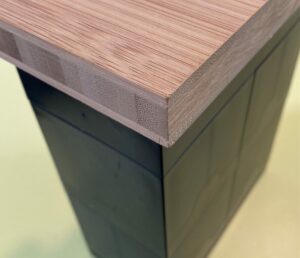Here at Engaging Interiors Ltd we’re delighted to be working on our first truly sustainable project. A university in the South East asked us to design them a zero waste shop. With the project manager we initially discussed ways of approaching a design that will minimise the impact of fit-out as well as adapting alongside the changing needs of the shop. This is how circular, sustainable design works – adapting the interior design process to work with the circular economy. We use our working knowledge of sustainable materials along with our common sense. And we apply this creatively to create a shop that will do less harm and can accommodate the university’s future needs.
How did we approach an agile, circular design for a zero waste shop?
We wanted to share the three stages in this zero waste shop interior design project: Construction, Operation and Deconstruction, in case circular design is something you’re considering.
Construction using circular design
In a previous article we showed why circular design makes a good business sense. One of the main advantages is the possibility to shorten a project’s construction phase, minimising down-time and maximising your budget.
For this zero waste shop the largest element of the fit-out is the interior fittings. We have sourced retail shelving that can be delivered and assembled in a day, yet still has the robustness and efficiency of a fitted system. It is constructed using a byproduct from the kitchen manufacturing process. This means that the colour of the timbers used to make the shelving and its supports will be dictated by what is left over from the kitchens constructed at the time. This will lead to an exciting, spontaneous patchwork aesthetic. As the design develops we’re also looking at ways of minimising how much timber we use, as conserving materials is another important consideration in circular design.

For the construction of the shop till counter and back counter we’ve specified a brand new product designed and developed during the Coronavirus lockdown period. It is a building block style product made from 100% recycled plastic, and is 100% recyclable. The producers have also offered to buy the blocks back once the university has finished with them. You can’t get much more circular than that!
We are bringing in other items like flooring and lighting as new items, but these also have good sustainable credentials. Like the stunning cardboard-constructed pendants by Tabitha Bargh.

When you set out to build an interior with circular design principles you need to ask these questions before specifying each element:
- Can I repurpose something that already exists? Yes – great, use it. No – go to next question.
- Is the material I am using sustainable? Yes – great, use it. No – go to next question.
- If you need to use a less sustainable material will it be usable after you have finished with it?
As you can imagine, it’s best to design your interior so that you never get to question 3.
Operation
When operating any type of business your customers will give you continuous feedback on what they want and what they don’t want from you. As you operate your business you might observe that a certain type of dessert or seating area in your restaurant isn’t popular, or that there’s a product range in your shop that isn’t selling well. It is important to notice these trends and adapt. Which is why a truly sustainable interior is one that incorporates adaptability and flexibility into its design.
From an operations viewpoint our design aims to make the shelving / retail system fully flexible so that we can modify each module to display each product to optimum effect. We also want to make it possible to change the layout of the shop without major works. This has meant designing an interior where nothing is nailed down or permanently fixed.
The till area / counter design is also adaptable. So, if our client requires an additional till station they can simply order more blocks and extend the countertop to suit.

Deconstruction
Shops and restaurants close for different reasons. Depending on the size of the operator, there is sometimes more than one option for repurposing the interior. If you’re a chain of shops and you’re able to open another site in another location you can obviously just move the shelving and fit-out furniture from one space to the next. It will be harder to repurpose or sell on your interior fittings if:
- You have metres of recessed built-in shelving supports
- Your lighting is plastered in
- Your fixed seating is fixed.
Items like flooring and ceilings have differing levels of permanence depending on the system specified. As a company we don’t dictate to our clients that they have to go for the most sustainable option, but we will choose it given the chance. The ease of using items that can be delivered and installed within a day also applies at the end of their life.
Interior design has relied on fitted furniture that has to be ripped out without any feasible reuse for decades – now it’s time for a change. Let’s work towards a more flexible and resilient future. It’s right for the planet. And it makes good business sense.